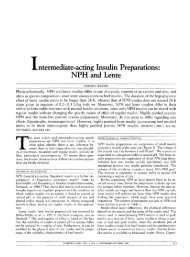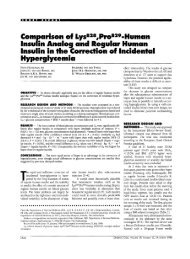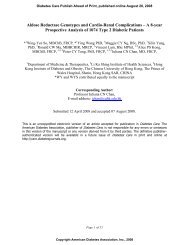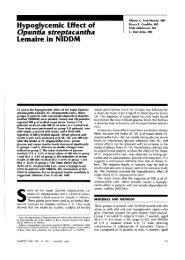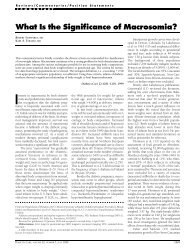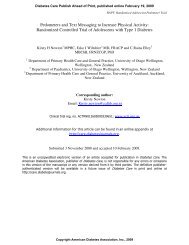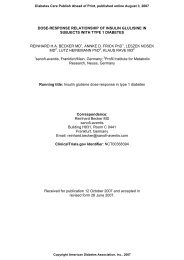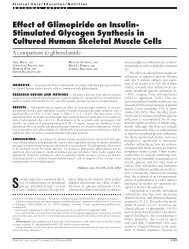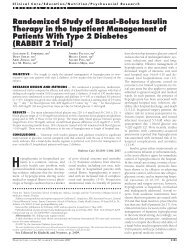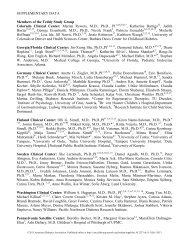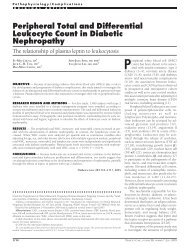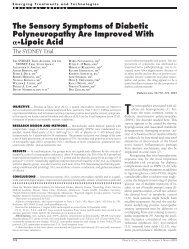Sex Differences in Incidence of IPPM in Age-Group ... - Diabetes Care
Sex Differences in Incidence of IPPM in Age-Group ... - Diabetes Care
Sex Differences in Incidence of IPPM in Age-Group ... - Diabetes Care
You also want an ePaper? Increase the reach of your titles
YUMPU automatically turns print PDFs into web optimized ePapers that Google loves.
O R I G I N A L A R T I C L E<br />
<strong>Sex</strong> <strong>Differences</strong> <strong>in</strong> <strong>Incidence</strong> <strong>of</strong><br />
<strong>IPPM</strong> <strong>in</strong> <strong>Age</strong>-<strong>Group</strong> 15-29 Yr<br />
Higher risk <strong>in</strong> males <strong>in</strong> Prov<strong>in</strong>ce <strong>of</strong> Tur<strong>in</strong>, Italy<br />
GRAZIELLA BRUNO, MD<br />
FRANCO MERLETTI, MD<br />
ANTONIO VUOLO, PHD<br />
EUSABETTA PlSU, MD<br />
MAURO GIORIO, BAS<br />
GLANFRANCO PAGANO, MD<br />
OBJECTIVE— To report the <strong>in</strong>cidence <strong>of</strong> IDDM <strong>in</strong> the age-group 0-29 yr <strong>in</strong> the<br />
Prov<strong>in</strong>ce <strong>of</strong> Tur<strong>in</strong>, Italy (951,445 <strong>in</strong>habitants 0-29 yr <strong>of</strong> age), over a 5-yr period<br />
(1984-1988) accord<strong>in</strong>g to age, sex, and geographical region wii:h<strong>in</strong> the area and to<br />
identify any temporal trend.<br />
RESEARCH DESIGN AND METHODS— The survey used as the primary data<br />
source the list <strong>of</strong> all patients attend<strong>in</strong>g diabetic cl<strong>in</strong>ics, and as secondary data source,<br />
used the list <strong>of</strong> hospital discharges for diabetes.<br />
RESULTS— We identified 298 <strong>in</strong>cident cases <strong>of</strong> IDDM <strong>in</strong> people 0-29 yr <strong>of</strong> age.<br />
Estimated completeness <strong>of</strong> ascerta<strong>in</strong>ment <strong>of</strong> the registry was 97%. <strong>Age</strong>-adjusted<br />
(world-standard) <strong>in</strong>cidence rates were 7.40/100,000 (95% CI 6.28-8.71), 5.83<br />
(4.95-6.86), and 6.70 (5.97-7.51), respectively, <strong>in</strong> the age-groups 0-14, 15-29,<br />
and 0-29 yr. <strong>Incidence</strong> was significantly higher <strong>in</strong> males than <strong>in</strong> females <strong>in</strong> the<br />
age-group 15-29 yr (7.36, 6.02-8.98, vs. 4.21, 3.12-5.56). An <strong>in</strong>creas<strong>in</strong>g <strong>in</strong>cidence<br />
from rural areas to the greater Tur<strong>in</strong> area (city and its <strong>in</strong>dustrial belt) was<br />
evident. No significant temporal trend dur<strong>in</strong>g the study period was found, although<br />
year-to-year variability was evident, with the highest <strong>in</strong>cidence <strong>in</strong> 1984.<br />
CONCLUSIONS— This study suggests a high male-to-female ratio <strong>of</strong> <strong>in</strong>cidence <strong>of</strong><br />
IDDM after 14 yr; either sex hormones or different exposure to environmental<br />
determ<strong>in</strong>ants could be <strong>in</strong>volved.<br />
I<br />
n recent years, the <strong>in</strong>creas<strong>in</strong>g <strong>in</strong>terest<br />
<strong>of</strong> diabetologists <strong>in</strong> the epidemiology<br />
<strong>of</strong> IDDM has resulted <strong>in</strong> the worldwide<br />
<strong>in</strong>stitution <strong>of</strong> population-based<br />
registries (1). <strong>Incidence</strong> data are available<br />
<strong>in</strong> many geographical areas now, as part<br />
<strong>of</strong> either Eurodiab (2) or Diamond<br />
Projects (3), show<strong>in</strong>g a strik<strong>in</strong>g dishomogeneous<br />
distribution <strong>of</strong> the disease.<br />
However, most available data are limited<br />
FROM THE INSTITUTE OF INTERNAL MEDICINE, AND THE UNIT OF CANCER EPIDEMIOLOGY, DEPARTMENT OF<br />
BIOMEDICAL SCIENCES AND HUMAN ONCOLOGY, UNIVERSITY OF TURIN, TURIN, ITALY.<br />
ADDRESS CORRESPONDENCE AND REPRINT REQUESTS TO PROF. G. PAGANO, INSTITUTE OF INTERNAL<br />
MEDICINE, CORSO DOGLIOTTI 14, 10126 TORINO, ITALY.<br />
RECEIVED FOR PUBLICATION 24 JUNE 1992 AND ACCEPTED 30 JULY 1992.<br />
IDDM, INSULIN-DEPENDENT DIABETES; CI, CONFIDENCE INTERVAL.<br />
to the age-group 0-14 yr, which <strong>in</strong>cludes<br />
just a proportion <strong>of</strong> <strong>in</strong>cident cases;<br />
<strong>in</strong> the light <strong>of</strong> the hypothesis that<br />
recently suggested (4) that determ<strong>in</strong>ants<br />
<strong>of</strong> IDDM could differ with age, further<br />
data <strong>in</strong> young adults are needed.<br />
Recently, <strong>in</strong> Sweden, an area at<br />
high risk for IDDM, an <strong>in</strong>creas<strong>in</strong>g maleto-female<br />
ratio after puberty has been<br />
described <strong>in</strong> a survey <strong>in</strong>clud<strong>in</strong>g the agegroup<br />
15-34 yr, suggest<strong>in</strong>g a role for sex<br />
hormones <strong>in</strong> the etiopathogenesis <strong>of</strong><br />
IDDM (5). At this time, data on the <strong>in</strong>cidence<br />
<strong>of</strong> IDDM <strong>in</strong> young adults <strong>in</strong> areas<br />
at lower risk, such as the Mediterranean<br />
countries, are limited (6-8).<br />
A 3-yr survey <strong>in</strong> the age-group<br />
0-29 yr <strong>in</strong> the city <strong>of</strong> Tur<strong>in</strong> (7-8) was<br />
expanded to 5 yr (1984-1988) and to<br />
the population <strong>of</strong> the whole Prov<strong>in</strong>ce <strong>of</strong><br />
Tur<strong>in</strong>. <strong>Incidence</strong> was analyzed accord<strong>in</strong>g<br />
to age, sex, seasonality, geographic subareas,<br />
and year <strong>of</strong> diagnosis.<br />
RESEARCH DESIGN AND<br />
METHODS— The highly <strong>in</strong>dustrialized<br />
Prov<strong>in</strong>ce <strong>of</strong> Tur<strong>in</strong> covers an area <strong>of</strong><br />
6830 km 2 <strong>in</strong> the Piedmont Region, <strong>in</strong> the<br />
northwestern part <strong>of</strong> Italy, and has<br />
951,445 <strong>in</strong>habitants 0-29 yr <strong>of</strong> age as <strong>of</strong><br />
1981 general census (city <strong>of</strong> Tur<strong>in</strong>:<br />
440,421; <strong>in</strong>dustrial belt: 181,720; rest <strong>of</strong><br />
the prov<strong>in</strong>ce, ma<strong>in</strong>ly rural: 329,304).<br />
Incident cases among residents <strong>of</strong><br />
the city <strong>of</strong> Tur<strong>in</strong> <strong>in</strong> 1984-1986 were<br />
identified <strong>in</strong> 1987 <strong>in</strong> a pilot survey (7,8),<br />
which showed a good validity and completeness<br />
<strong>of</strong> ascerta<strong>in</strong>ment <strong>of</strong> cases when<br />
the files <strong>of</strong> either diabetic cl<strong>in</strong>ics or hospital<br />
discharges were used. These two<br />
data sources were used to extend identification<br />
<strong>of</strong> cases to the whole Prov<strong>in</strong>ce <strong>of</strong><br />
Tur<strong>in</strong> s<strong>in</strong>ce 1984. Inclusion criteria for<br />
rates estimates were as follows: 1) diagnosis<br />
<strong>of</strong> IDDM from 1 January 1984 to<br />
31 December 1988; 2) 0-29 yr <strong>of</strong> age at<br />
diagnosis; and 3) residence <strong>in</strong> the Prov<strong>in</strong>ce<br />
<strong>of</strong> Tur<strong>in</strong> at onset <strong>of</strong> the disease.<br />
Criteria used for diagnosis <strong>of</strong> IDDM were<br />
those def<strong>in</strong>ed by National <strong>Diabetes</strong> Data<br />
<strong>Group</strong> (9). Date <strong>of</strong> onset <strong>of</strong> the disease<br />
was the start <strong>of</strong> <strong>in</strong>sul<strong>in</strong> treatment.<br />
DIABETES CARE, VOLUME 16, NUMBER 1, JANUARY 1993 133
<strong>Sex</strong> differences <strong>in</strong> <strong>in</strong>cidence <strong>of</strong> IDDM<br />
Table 1—<strong>Age</strong>-specific <strong>in</strong>cidence rates (per 100,000 person-yr) <strong>of</strong>lDDMfor residents <strong>of</strong> Prov<strong>in</strong>ce <strong>of</strong> Tur<strong>in</strong> from 1984 to 1988<br />
AGE<br />
(YR)<br />
0-4<br />
5-9<br />
10-14<br />
15-19<br />
20-24<br />
25-29<br />
0-14<br />
15-29<br />
0-29<br />
n, number <strong>of</strong> cases.<br />
N<br />
12<br />
23<br />
46<br />
41<br />
32<br />
24<br />
81<br />
97<br />
178<br />
MALES<br />
AGE-SPECIFIC<br />
INCIDENCE RATE<br />
(95% CD<br />
4.98 (2.57-8.71)<br />
7.84(4.97-11.76)<br />
11.75(8.57-15.74)<br />
9.22 (6.58-12.54)<br />
6.90 (4.73-9.73)<br />
5.85 (3.75-8.72)<br />
8.75 (6.98-10.94)<br />
7.36 (6.02-8.98)<br />
7.93 (6.84-9.20)<br />
Statistical analysis<br />
The estimated completeness <strong>of</strong> both the<br />
primary data source and the registry was<br />
computed with the capture-recapture<br />
method (10). Data on the age and sex<br />
composition <strong>of</strong> the population <strong>of</strong> the<br />
Prov<strong>in</strong>ce <strong>of</strong> Tur<strong>in</strong> were available from the<br />
general census <strong>of</strong> 1981 and from subsequent<br />
<strong>in</strong>tercensual estimates for 1984,<br />
1985, 1986, and 1987. Incident rates for<br />
1988 were computed from the 1987 estimates.<br />
Denom<strong>in</strong>ators <strong>of</strong> <strong>in</strong>cidence rates<br />
over 1984-1988 were the sum <strong>of</strong> the<br />
denom<strong>in</strong>ators <strong>of</strong> each year (4,387,097<br />
N<br />
11<br />
19<br />
37<br />
19<br />
21<br />
13<br />
67<br />
53<br />
120<br />
FEMALES<br />
AGE-SPECIFIC<br />
INCIDENCE RATE<br />
(95% CD<br />
4.82 (2.41-8.63)<br />
6.78 (4.08-10.57)<br />
9.86 (10.57-13.56)<br />
4.47 (2.69-6.97)<br />
4.84 (2.9959-7.41)<br />
3.26(1.73-5.57)<br />
7.58 (5.87-9.74)<br />
4.21 (3.12-5.56)<br />
5.60 (4.66-6.72)<br />
person-yr
Bruno and Associates<br />
Table 3—<strong>Age</strong>-specific <strong>in</strong>cidence rates (per 100,000 person-yr) <strong>of</strong>lDDMfor residents <strong>of</strong> Prov<strong>in</strong>ce <strong>of</strong> Tur<strong>in</strong> from 1984 to 1988<br />
YEAR<br />
1984<br />
1985<br />
1986<br />
1987<br />
1988<br />
n, number<br />
<strong>of</strong> cases.<br />
N<br />
39<br />
30<br />
22<br />
30<br />
27<br />
0-14<br />
AGE-SPECIFIC<br />
INCIDENCE RATE<br />
(95% CD<br />
10.02(7.15-13.63)<br />
8.07(5.45-11.54)<br />
6.26 (3.92-9.45)<br />
8.95 (6.04-12.80)<br />
8.06(5.31-11.77)<br />
females, and the sex ratio tended to <strong>in</strong>crease<br />
with age. Statistical significance<br />
(i.e., no overlapp<strong>in</strong>g between the two<br />
CIs) <strong>of</strong> the difference between sexes was<br />
atta<strong>in</strong>ed for rates computed for ages<br />
0-29 and 15-29. <strong>Age</strong>-adjusted (worldstandard)<br />
<strong>in</strong>cidence rates/100,000 were<br />
7.40 (95% CI 6.28-8.71), 5.83 (4.95-<br />
6.86), and 6.70 (5.97-7.51), respectively,<br />
<strong>in</strong> the age-groups 0-14, 15-29,<br />
and 0-29 yr. As shown <strong>in</strong> Table 2, <strong>in</strong><br />
both sexes
<strong>Sex</strong> differences <strong>in</strong> <strong>in</strong>cidence <strong>of</strong> IDDM<br />
t<strong>in</strong>a Calefato, Quirico Carta, Raffaele<br />
Castellazzi, Franco Cerutti, Anna Chiambretti,<br />
Marco Comoglio, Luciano Corgiat<br />
Mans<strong>in</strong>, Annunziata D'Urso, Domenico<br />
Fonzo, Silvia Gamba, Carlo Giorda, Aurora<br />
Grassi, Giorgio Grassi, Anna Marocco,<br />
Valent<strong>in</strong>o Mart<strong>in</strong>a, Ferd<strong>in</strong>ando<br />
Melo', Guglielmo Morra, Gianfranco Pagano,<br />
Gianna Patrucco, Elisabetta Pisu,<br />
Luigi Rasetti, Carla Sacchetti, Roberto<br />
Sivieri, Milena Tagliabue, Mariella Trovati,<br />
Massimo Veglio, Federico Vitelli.<br />
References<br />
1. Rewers M, LaPorte RE, K<strong>in</strong>g H, Tuomilehto<br />
J: Trends <strong>in</strong> the prevalence and<br />
<strong>in</strong>cidence <strong>of</strong> diabetes: <strong>in</strong>sul<strong>in</strong>-dependent<br />
diabetes mellitus <strong>in</strong> childhood. World<br />
Health Stat Q 41:179-89, 1988<br />
2. Green A, Gale EAM, Patterson CC, for<br />
the Eurodiab ACE Study <strong>Group</strong>: <strong>Incidence</strong><br />
<strong>of</strong> childhood-onset <strong>in</strong>sul<strong>in</strong>-dependent<br />
diabetes mellitus: the EU-<br />
RODIAB ACE Study. Lancet 339:905-<br />
909,1992<br />
3. WHO DIAMOND Project <strong>Group</strong>: WHO<br />
Mult<strong>in</strong>ational Project for Childhood <strong>Diabetes</strong>.<br />
<strong>Diabetes</strong> <strong>Care</strong> 13:1062-68, 1990<br />
4. Dahlquist G, Blom LG, Lonnberg G: The<br />
Swedish childhood diabetes study—a<br />
multivariate analysis <strong>of</strong> risk determ<strong>in</strong>ants<br />
for diabetes <strong>in</strong> different age groups. Diabetologia<br />
34:757-62, 1991<br />
5. BlohmeG, Nystrom L, ArnquistHJ, Lithner<br />
F, Littor<strong>in</strong> B, Olsson PO, Schersten B,<br />
Wibell L, Ostman J: Male predom<strong>in</strong>ance<br />
<strong>of</strong> type 1 (<strong>in</strong>sul<strong>in</strong>-dependent) diabetes<br />
mellitus <strong>in</strong> young adults: results from a<br />
5-year prospective nationwide study <strong>of</strong><br />
the 15-34-year age group <strong>in</strong> Sweden.<br />
Diabetologia 35:56-62, 1992<br />
6. Goday A, Castell C, Tresserras R, Canela<br />
J, Tabemer JL, Lloveras G, and the Catalan<br />
Epidemiology <strong>Diabetes</strong> Study<br />
<strong>Group</strong>: <strong>Incidence</strong> <strong>of</strong> type 1 (<strong>in</strong>sul<strong>in</strong>dependent)<br />
diabetes mellitus <strong>in</strong> Catalo-<br />
nia, Spa<strong>in</strong>. Diabetologia 35:267-71, 1992<br />
7. Bruno G, Merletti F, Pisu E, Pastore G,<br />
Marengo C, Pagano G: <strong>Incidence</strong> <strong>of</strong><br />
IDDM dur<strong>in</strong>g 1984-1986 <strong>in</strong> population<br />
aged



